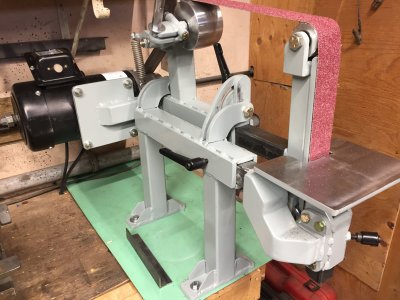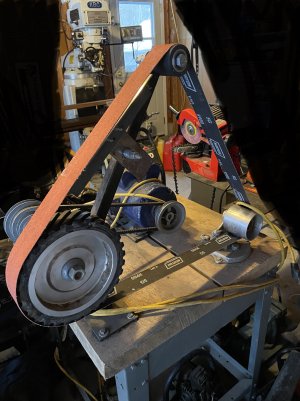That was why I went with the 2x48. The footprint of the 2x72 is just not workable in my shop.Just watched Phil Vandelay's last installment where he constructs dust/spark containment, I think I'll go with something like that.
Just a note for anyone thinking about building a 2x72, take note of the length of the footprint, Jer's Gen2 has a minimum length of 34", with a catch pan, 38-40".
For some reason I thought it was shorter and the spot I had planned for it is not going to work, wishing now that I had gone for a 2x48 instead.
Identical capabilities but compact.
-
Scam Alert. Members are reminded to NOT send money to buy anything. Don't buy things remote and have it shipped - go get it yourself, pay in person, and take your equipment with you. Scammers have burned people on this forum. Urgency, secrecy, excuses, selling for friend, newish members, FUD, are RED FLAGS. A video conference call is not adequate assurance. Face to face interactions are required. Please report suspicions to the forum admins. Stay Safe - anyone can get scammed.
-
Several Regions have held meetups already, but others are being planned or are evaluating the interest. The Calgary Area Meetup is set for Saturday July 12th at 10am. The signup thread is here! Arbutus has also explored interest in a Fraser Valley meetup but it seems members either missed his thread or had other plans. Let him know if you are interested in a meetup later in the year by posting here! Slowpoke is trying to pull together an Ottawa area meetup later this summer. No date has been selected yet, so let him know if you are interested here! We are not aware of any other meetups being planned this year. If you are interested in doing something in your area, let everyone know and make it happen! Meetups are a great way to make new machining friends and get hands on help in your area. Don’t be shy, sign up and come, or plan your own meetup!
You are using an out of date browser. It may not display this or other websites correctly.
You should upgrade or use an alternative browser.
You should upgrade or use an alternative browser.
2x72 grinder discussion
- Thread starter Six O Two
- Start date
TorontoBuilder
Sapientia et Doctrina Stabilitas
We use our cold room as a dedicated grinding room, with three bench grinders, and soon to be belt grinder. In use, the closed door and the dust extraction keeps the room at a negative pressure so no grinding dust gets into the basement. A checker aluminum plate on the wall and lack of combustibles means no fire hazard from sparks.You do see the irony here, right ?
For the same reason I have the heat treatment oven in the cold room as well.
Can you post some pictures of a 2” grinder you have built?I build you a grinder with VFD for $1500.
Custom.
Made in Calgary.
2hp or 3hp motor.
Heavy duty. I mean HEAVY DUTY.
I got the basic machine assembled today and made some sparks fly, I saw immediately that 1725 rpm is really not going to cut it. Should have gone with the 3400 rpm motor or 3 ph.
Still, it's usable for the moment.
I haven't made all the other attachments yet but for now will just build the adjustable angle table, the XY table and the magnetic chuck.
The last pic before it gets dirty.
Still, it's usable for the moment.
I haven't made all the other attachments yet but for now will just build the adjustable angle table, the XY table and the magnetic chuck.
The last pic before it gets dirty.
Attachments
Looks awesome!I got the basic machine assembled today and made some sparks fly, I saw immediately that 1725 rpm is really not going to cut it. Should have gone with the 3400 rpm motor or 3 ph.
Still, it's usable for the moment.
I haven't made all the other attachments yet but for now will just build the adjustable angle table, the XY table and the magnetic chuck.
The last pic before it gets dirty.
Dan Dubeau
Ultra Member
Looks great! Nice job on the build. What size drive wheel are you running? I'm going to make a 6" one ( think I'm finally settled on that....), which will put me at the low end for "serious" metal removal (2800sfm) with my 1800rpm motor, but the VFD will allow me to speed it up, or down from there easily when needed. I was originally going to run a 7", but read somewhere that it's better to speed a motor up, than slow it down because of cooling (would overheat running slower with less air flow), so I'd rather be on the slower side at stock RPM. Whether that's true on not, I don't know, but it sounds plausible.I got the basic machine assembled today and made some sparks fly, I saw immediately that 1725 rpm is really not going to cut it. Should have gone with the 3400 rpm motor or 3 ph.
Still, it's usable for the moment.
I haven't made all the other attachments yet but for now will just build the adjustable angle table, the XY table and the magnetic chuck.
The last pic before it gets dirty.
I was originally going to run a 7", but read somewhere that it's better to speed a motor up, than slow it down because of cooling (would overheat running slower with less air flow), so I'd rather be on the slower side at stock RPM. Whether that's true on not, I don't know, but it sounds plausible.
It is true, but only at significant speed differences and only for motors that are not already designed to run at the lower speeds. For non-sealed motors, the easiest way to deal with it for a motor that isn't designed for it is to add an electric cooling fan.
Higher speeds isn't necessarily good either. Usually that is a bearing limitation.
Most non VFD rated motors can be run from about 45hz to 75hz without worrying about it at all. If it won't be operated for long periods or with heavy loads you can go from 40 to 80 (2:1).
Dan Dubeau
Ultra Member
So a 2 pole 3600rpm TEFC motor will have no problem running at say 30hz or lower for an extended period of time?
I wish I bookmarked what site that was on, most likely one of the blade/knife/blacksmith forums out there. but it was a pretty lengthy discussion where some good points were made about preferring 4pole 1800rpm motors for grinders and speeding them up when needed, vs 2pole 3600 motors and dialing them down, and them running hot. Initially I'd regretted my 1800rpm motor, and contemplated buying a 3600rpm one, but after reading more about it, I'm fine with it now. I doubt I'll ever be running it long enough for either scenario to play out anyway.
I wish I bookmarked what site that was on, most likely one of the blade/knife/blacksmith forums out there. but it was a pretty lengthy discussion where some good points were made about preferring 4pole 1800rpm motors for grinders and speeding them up when needed, vs 2pole 3600 motors and dialing them down, and them running hot. Initially I'd regretted my 1800rpm motor, and contemplated buying a 3600rpm one, but after reading more about it, I'm fine with it now. I doubt I'll ever be running it long enough for either scenario to play out anyway.
So a 2 pole 3600rpm TEFC motor will have no problem running at say 30hz or lower for an extended period of time?
I did not say that. I said:
Most non VFD rated motors can be run from about 45hz to 75hz without worrying about it at all. If it won't be operated for long periods or with heavy loads you can go from 40 to 80 (2:1).
To hit your 30 or lower for extended periods on a Totally Enclosed Motor, you will need a VFD rated motor.
I also said that
For non-sealed motors, the easiest way to deal with it for a motor that isn't designed for it is to add an electric cooling fan.
It can't be a TEFC motor cuz they won't allow a cooling fan to circulate air through the motor for cooling.
Dan Dubeau
Ultra Member
Sorry, Assume since I was talking about a vfd, that the motor would be VFD rated. My apologies for not including that info. Your last post makes sense. Thanks.
Thanks, I have a 5" drive wheel on the motor.Looks great! Nice job on the build. What size drive wheel are you running?
Sorry, Assume since I was talking about a vfd, that the motor would be VFD rated. My apologies for not including that info. Your last post makes sense. Thanks.
Yes, that changes things. But even VFD rated motors come in different flavours. A 5:1 motor can be run at 3 Hz for a long period of time. A 2:1 can be run at 30Hz for a long time. A 1000:1 motor can be stalled at full torque.
You really have to do your research ahead of time. The specs will usually tell you the turn-down ratio as well as the duty cycle. They might also specify the max speed too!
BaitMaster
Ultra Member
@skippyelwell
I crank my 1780 rpm motor up to like 4000rpm on a drive on my grinder. Then she shoots sparks.
Bearings are cheap. Not gonna hurt the motor. It is VFD rated.
I crank my 1780 rpm motor up to like 4000rpm on a drive on my grinder. Then she shoots sparks.
Bearings are cheap. Not gonna hurt the motor. It is VFD rated.
Not gonna hurt the motor. It is VFD rated.
2.2 to 1 eh. That's quite the jump. With your easy access to nice motors, you are the guy to try it! Me, hard pass.
Even my 1000:1 motor isn't rated for that. Manufacturer's recommendation is 120Hz max. But I sent them an info request just now to qualify that. I'd love to be able to go to 4000 rpm cuz I could skip the 2spd gear box completely.
BaitMaster
Ultra Member
I’ll do it on a grinder…. Wouldn’t do it on a lathe.2.2 to 1 eh. That's quite the jump. With your easy access to nice motors, you are the guy to try it! Me, hard pass.
Even my 1000:1 motor isn't rated for that. Manufacturer's recommendation is 120Hz max. But I sent them an info request just now to qualify that. I'd love to be able to go to 4000 rpm cuz I could skip the 2spd gear box completely.
They say 120hz so 3600rpm…..
A 3600rpm 2p motor has the same bearings. Not gonna blow it up if you overspeed it by 10%.
The thing that’s going to kill it is if you set your overload to high…..
Hollow-Grind
Active Member
Tom Kitta
Ultra Member
![PXL_20250207_234810486[1].jpg PXL_20250207_234810486[1].jpg](https://canadianhobbymetalworkers.com/data/attachments/68/68378-74d67e5745dc3be51d56fd753eeaeebe.jpg?hash=nzrk3n6Csy)
![PXL_20250207_234815723.MP[1].jpg PXL_20250207_234815723.MP[1].jpg](https://canadianhobbymetalworkers.com/data/attachments/68/68379-69fb457f5609be4694c808550a021b50.jpg?hash=wuJSHt9HCg)
![PXL_20250207_234825925[1].jpg PXL_20250207_234825925[1].jpg](https://canadianhobbymetalworkers.com/data/attachments/68/68380-0d7fa6c837bb5b07ae2034ee10e3cc51.jpg?hash=wlkgAMNWDD)
![PXL_20250207_234849471.MP[1].jpg PXL_20250207_234849471.MP[1].jpg](https://canadianhobbymetalworkers.com/data/attachments/68/68381-c1c83fd42606d6105a46beb38a5eff15.jpg?hash=BROvSwaB8U)
This took about a week to build - way faster then the power hammer project.
Has about 20h of use on it.
Main issue is tracking. It has tendency to work fine multiple times and then just throws the belt off.
Heck I can do multiple things for like 20 min of use and then suddenly it throws the belt off!
That has got to be the best minimalist build ever.Here’s my vintage 2x72. Had this thing at least 15 or 20 years. Will take a lot of metal off.
View attachment 60491



